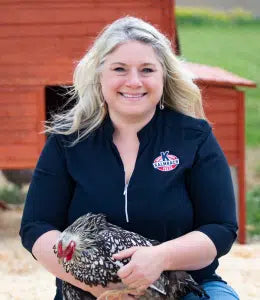Molting Chickens Guide: Why Do Chickens Molt?

Ahhh!!! The fall season is a favorite for most of us - the cooler weather, the changing leaves, the yummy food. The fall season is a signal for us to enjoy the weather and prepare for winter. While we enjoy some yummy comfort food and our favorite pumpkin-spiced treats, our feathered friends are also preparing.
Fall is molting season for poultry. A molt is a natural process in which hens will stop laying eggs and begin to lose and then regenerate new feathers. Depending on where you live, molting may start as early as August or as late as November. Most of us are going to be right in the middle of molting season in late September and October.
2 Main Reasons for Chickens Molting
Reason #1 for Molting Chickens: Egg Production
If you have been keeping up with our Layer Days series, you may have heard us mention that it really helps to think of egg production as its core purpose. Egg production is reproduction! And, if we think of egg production as reproduction, molting just makes sense.
Picture it. An Ohio Backyard, 1920. A hen lays most of her eggs in the spring and summer because this is when she has the best chance of successfully raising new baby chicks. Spring and summer are when the mating season is in full swing, food sources are plentiful, and the temperature is adequate for her baby chicks to thrive. Of course, as summer fades, the natural food sources and warm temperatures start to fade too and the resources needed for successful reproduction fade with it.
Today, resources for our backyard birds are plentiful but this primal instinct is still there. In fact, this instinct is hard-wired into the genetics of our feathered friends. Molting is a natural process, and it is signaled by decreasing daylight hours. Chickens usually require about 12-18 hours of daylight (or artificial light, if you choose) to stay at peak production. Once the daylight hours start to decrease in the fall, there is a natural decrease in egg production. When a hen stops laying eggs or starts laying fewer eggs, her reproductive tract has a chance to take a break and regenerate new and healthy tissue. Once she begins laying again at full production, her eggs are often higher quality and have stronger shells. Molts may last anywhere from 2 weeks to 2+ months. The duration of a molt can vary quite a bit depending on the age and breed of your bird. Also, since we are thinking about egg production as reproduction, our young birds (at their reproductive peak!) may even skip the molt their first season and continue to lay all fall and winter.
Reason #2 for Molting Chickens – Feather Production
Now, molting isn’t all about egg production. If it was, we wouldn’t have molting roosters too! Molting helps ALL of our birds prepare for winter. As winter approaches, most of us are going to get our warm cozy blankets out of storage. Your birds are essentially doing the same thing by dropping old feathers and replacing them with new and healthy feathers. Chickens keep themselves warm by fluffing up their feathers, trapping air, and warming that trapped air with their body heat. This is very similar to the way a blanket works! Also, at 105oF to 107oF, a chicken’s body temperature is much higher than a human. New and healthy feathers help birds trap more of this warm air; thus, keeping them more comfortable during the colder winter months.
Try Kalmbach Feeds® for Healthy, Happy Chickens
At Kalmbach Feeds, we take the health of your chickens seriously. To learn more about raising backyard chickens, check out the Kalmbach Feeds chicken blog.
